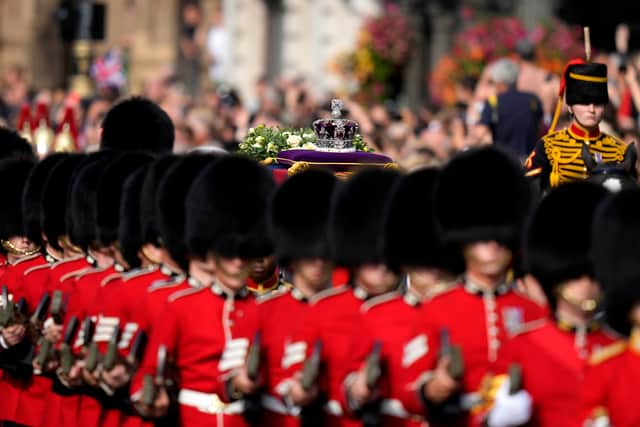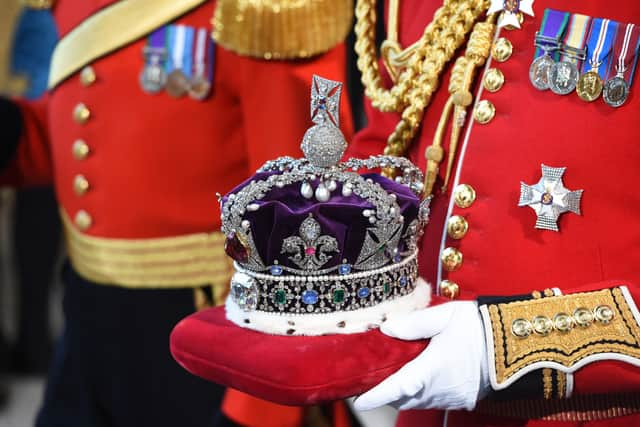What is the crown on the Queen’s coffin? How heavy is it, how much is it - and where are the crown jewels kept
and live on Freeview channel 276
The Queen’s state funeral has taken place today at Westminster Abbey.
The late monarch lay in state at Westminster Hall for four days before making her journey to the Abbey by Royal procession.
Advertisement
Hide AdAdvertisement
Hide AdTransport for London (TfL) have issued a travel warning, with one million people expected to travel to the capital to pay their respects to the Queen.
The Queen’s casket has been adorned with flowers from her garden in Balmoral and a Royal Standard flag.
But what is the crown on top of the Queen’s coffin? Here’s everything you need to know.


What is the crown on the Queen’s coffin?
The crown that rests on top of the Queen’s coffin is the Imperial State Crown.
Advertisement
Hide AdAdvertisement
Hide AdIt was made for the coronation of the Queen’s father, King George VI in 1937, replacing the crown made for Queen Victoria.
The Queen wore it after her own coronation in 1953 and annually for the State Opening of Parliament.
Made from gold, the crown is set with 2,868 diamonds, 17 sapphires, 11 emeralds, 269 pearls, and four rubies.
According to the Historic Royal Palace website: “The crown contains some of the most famous jewels in the collection. These include the Black Prince’s Ruby, the Stuart Sapphire, and the Cullinan II diamond.”
Advertisement
Hide AdAdvertisement
Hide AdThe St Edward’s Sapphire is said to have come from a ring worn by St Edward the Confessor, which was discovered in 1163 when his coffin was moved to another shrine in Westminster Abbey.
The Imperial State Crown is kept in the Tower of London with the monarch’s Crown Jewels.


How heavy is it?
The Imperial Crown is heavy, weighing in at just over 1kg.
Speaking to the BBC in 2018, the Queen explained what it was like to wear.
Her Majesty said: “You can’t look down to read the speech, you have to take the speech up, because if you did your neck would break.”
Advertisement
Hide AdAdvertisement
Hide AdAdding: “There are some disadvantages to crowns, but otherwise they’re quite important things.”
During the State Opening of Parliament in 2019, a lighter crown was used and in 2021 she didn’t wear a crown.
How expensive is the Queen’s crown?
The Queen’s Imperial Crown and Crown Jewels are said to be priceless.
They have never been appraised, offering historic and symbolic value instead.
Advertisement
Hide AdAdvertisement
Hide AdThe Imperial Crown was made with a collection of impressive gemstones, including the Black Prince’s Ruby, the Stuart Sapphire, and the Cullinan II diamond.
Whilst it’s unlikely they will ever be put up for sale, experts have estimated their value could be anywhere between £1 billion to £5 billion.
Where are the Crown Jewels kept?
The Crown Jewels are kept under guard at the Tower of London.
They had originally been kept at Westminster Abbey until the English Civil War when King Charles I was executed.
Advertisement
Hide AdAdvertisement
Hide AdFollowing his death, parliament destroyed all of the former king’s regalia, including the Crown Jewels.
In 1660, when the monarchy was reestablished, King Charles II ordered the creation of new Crown Jewels, which still make up the collection today.
Since then, there has only been one attempt to steal them.
In 1671 Colonel Thomas Blood tricked the Jewel House Keeper into showing them to him, before making off with the Imperial State Crown, the Orb and the Sovereign’s Sceptre.
The robbers were all caught, but surprisingly Blood managed to get off, without punishment.
King Charles II pardoned the Colonel for his crime and as a gesture of goodwill granted him land in Ireland.
Comment Guidelines
National World encourages reader discussion on our stories. User feedback, insights and back-and-forth exchanges add a rich layer of context to reporting. Please review our Community Guidelines before commenting.
